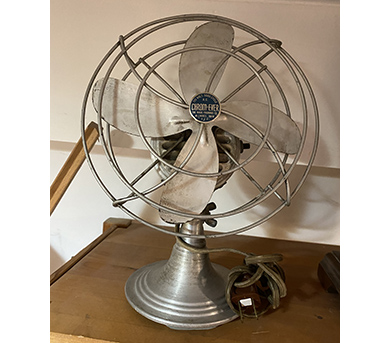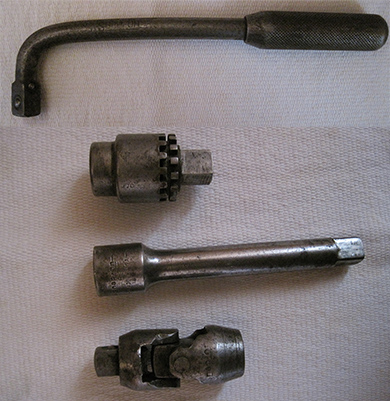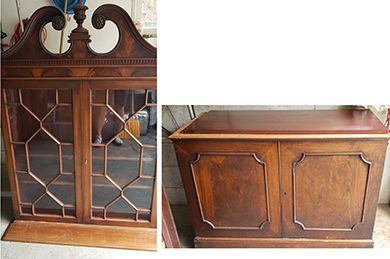 |
|
|||
 |
 |
|||
RINKER ON COLLECTIBLES — Column #1785 Copyright © Harry Rinker, LLC 2021 Questions
and Answers
QUESTION: I have a Chrom-Ever electric fan made by The Wade-Youmans Co. of Alliance, Ohio. The fan belonged to my mother. It was one of pair. When my mother plugged in one of the pair, it shorted out almost immediately. She threw out that fan and kept the second, never plugging it in to see if it worked. I understand fans are collectible and often used for décor display. What is the worth of my mother’s fan? – CJ, CT, Email Question 
ANSWER: In 1944, the Wade Youmans Company was listed in the Alliance, Ohio, business directory as a manufacturer of electrical parts. R. D. Wade and Charles Youmans were the founders and owners. From 1950 to 1952, the company is listed as an electrical appliance manufacturer. This is the most likely time period during which the company made the Chrom-Ever desk and box fans. Starting in 1953, Wade-Youmans is listed as a metal stamping manufacturer. In 1970, Charles Youmans is listed as the president. There is no record of the company after 1970. It is not clear if the company was closed, moved, or sold. The Alliance Historical Society (https://alliancehistory.org) welcomes pictures of the Chrom-Ever fans or any products with a Wade-Youmans label for inclusion in their files. Your fan style appears to be the desk fan. A “Wade Youmans” search on WorthPoint.com indicated the company also made a 1-quart electric churn. At some point, you are going to have to plug in your fan to see if it works. Non-working examples have little value. The image that accompanied your email shows that the fan blades have lost some of their chrome. The cost to re-chrome the blades and clean up the fan will exceed the end value. Hence, sell the fan as it stands. WorthPoint.com listings suggest a fan in unrestored but working condition has a value between $18.00 and $22.00. QUESTION: My mother-in-law was a 2nd Lieutenant in the World War II Army Nurse Corps. She was stationed in France and Germany during the period 1943 to 1945. During her time in the Nursing Corps, she accumulated a lot of stuff – military pronouncements (some which include her name), pictures, social do’s and don’ts, and war-related new articles. Should I donate the material a World War II museum, box it up and pass it down to my daughter, or just toss it out? I would appreciate your thoughts. – SD, PA, Email Question ANSWER: Before making a final decision, you need to gather addition information. First, find your mother-in-law’s service record. Look for discharge and/or service records. Of what group within the Army Nurse Corps was she a member? The number of Army nurses in the European theater reached a peak of over 17,000 by June 1945. The first nurses to arrive in Europe after D-Day were members of the 42nd and 45th Field Hospitals and the 91st and 128th Evacuation Hospitals. Second, does our mother-in-law’s material include any uniforms, badges, or other medals? Does the material contain photographs of your mother-in-law in uniform? These add significantly to the perceived value of the collection. There are multiple choices if you decide you want to donate the material. The National WWII Museum in New Orleans is one possibility. The Army Nurse Corps Association (ANCA) is an association dedicated to the Army Nurse Corps. One of ANCA’s aims is to document and preserve ANC and ANCA history. Unfortunately, it does not maintain an archives/museum site. My research failed to find a museum specifically dedicated to the US Army Nurse Corp or the US Navy Nurse Corp. Much to my surprise, I found little information on World War II re-enactment groups focusing on the Army Nurse Corp. I did find a Facebook page – www.facebook.com/ArmyNurseCorps/. I am certain your collection of material would be of interest to their members. The members of the group seem to be located in the Czech Republic and Poland and not in the United States. Recently, my wife Linda and I visited the Brevard Veterans Museum in Merritt Island, Florida. It is one of dozens of regional veterans’ museum whose collections are well maintained and displayed. I was impressed by what I saw. There most-likely are similar museums near where you live. Finally, consider contacting the historical society serving the community in which your mother-in-law lived at the time of her enlistment. Many local historical societies feature military displays focusing on service by members from the community. QUESTION: I have some early Snap On tools that belonged to my grandfather. I believe they date from the 1930s through the 1950s. There is a socket wrench and a few attachments. More parts than a full set. Do the tools have any monetary value to a collector? – BS, Carrollton, OH, Email Question 
ANSWER: In 1920, Joseph Johnson, a Milwaukee engineer, and William Seidemann spent weekends working on the concept of creating five unique handles and ten sockets that snapped on interchangeably. The goal was to create “Five to do the work of Fifty” tools. After creating two demonstration sets, Johnson and Seidemann secured over 500 orders. They founded the Snap-on-Wrench Company. A 2,500 square foot factory in Milwaukee was acquired. The first five hundred orders were filled in six months. The number 6 Ratchet (which is one of the parts you own) was patented in 1923, the same year Snap-on published its first catalog. By 1925, there were 17 branches and 165 salesmen selling Snap-on tool. I forwarded your email to Kevin McCalla of the Mid-West Tool Collectors Association (https://mwtca.org/). I had the privilege of being the featured speaker at one of its regional meetings. Kevin sent the email to several members of the M-WTCA who specialize in Snap-on tools. Dan Gaier, a wrench collector, replied: “These wrenches do not have much value since it is not a complete set and only in fair condition. I would value them at $25. If sold on eBay, they would go up to $50?” Dan’s assessment is spot on. Today’s collectors want “complete units.” They do not want or have the time to assemble a complete unit part by part. Also, tool collecting is highly specialized. Finding a Snap-on tool collector who does not already have the parts you have will be time consuming and almost impossible. My recommendation is to take any offer over $15.00 if you want to sell. If not, keep the collection as a conversation starter. QUESTION: I have a two-piece glass cabinet in fair condition that was made by the Paine Furniture Company. I do not know the date of the piece and am not certain of the type of wood. I do have the key for the locks. I was wondering what kind of value it might have? – JH, Hampton, NH, Email Question 
ANSWER: Based on the pictures that accompanied your email, you have a Colonial Revival Governor Winthrop top that rests on a non-descript base with two blind cabinet doors. The base stylistically is not in harmony with the top. The top is reminiscent of the Chippendale-style. The base has a modified Chippendale-style or Federal-style appearance. My first thought in seeing the pictures was that the tops and base were a harlequin (mismatched) pair. Your piece has no collecting value. Its value is reuse. My recommendation is to apply one of the many furniture renewing products found at Big Box stores such as Home Depot or Lowes. If this snaps-up the appearance of the cabinet to the point of “room ready” reusability, its secondary market reuse value is between $80.00 and $100.00. Harry L. Rinker welcomes questions from readers about
collectibles, those mass-produced items from the twentieth and twenty-first centuries.
Selected letters will be answered in this column.
Harry cannot provide personal answers.
Photos and other material submitted cannot be
returned.
Send your questions to: Rinker on Collectibles, 5955 Mill
Point Court SE, Kentwood, MI 49512.
You also can e-mail your questions to
harrylrinker@aol.com.
Only e-mails containing a full name and mailing address
will be considered.
|
||||